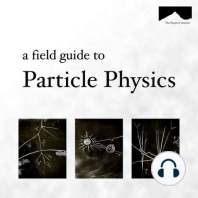3 min listen
The Charged Sigma Baryons
ratings:
Length:
10 minutes
Released:
Feb 11, 2022
Format:
Podcast episode
Description
The Field Guide to Particle Physics : Season 2https://pasayten.org/the-field-guide-to-particle-physics©2022 The Pasayten Institute cc by-sa-4.0The definitive resource for all data in particle physics is the Particle Data Group: https://pdg.lbl.gov.The Pasayten Institute is on a mission to build and share physics knowledge, without barriers! Get in touch.The Charged Sigma BaryonsIntroductionThe Sigma Baryons - that’s a capital Sigma - are a trio of slightly heavy cousins to everyday particles like the proton and the neutron. With masses of almost 1200 MeV each, it may surprise you that the physics of Sigma baryons feels much closer to a comparatively puny trio of familiar particles: the pions.The pions form a triplet of mesons: pi plus, pi zero and pi minus. So too, do the Sigmas: Sigma Plus, Sigma Zero and Sigma Minus. The similarities are helpful for building an intuition, but the differences are stark. While the charged pions are antiparticle partners, the charged Sigmas are anything but.Today we’ll focus on that fact as we explore the pair of particles Sigma Plus and Sigma Minus. Charged SigmasThe charged Sigma baryons are your typical strange particle. They live much longer than they should, given their mass. Their lifetime is a sizable fraction of a nanosecond. Like the Lambda Zero, the charged Sigma baryons live so long because they have to wait for their constituent strange quark to decay.The strange quark can only decay to an up quark, and while possible, it takes a while. It’s a quantum bottleneck that in particle decays that has come to be known as the technical term “Strangeness”. While the down quark and the strange quark have separate identities as far as the strong nuclear force is concerned, they mix slightly under the weak nuclear force. That slight mixing is what gives the strange quark a chance to decay.And it always decays to an up quark. Keep an eye on this fact. It’s what makes the Sigma baryon decays so tricky.What’s fun about the charged Sigma Baryons - that is markedly DIFFERENT than the charged pions - is that they are NOT antiparticles for one another. ¿The ANTI sigma plus is NOT the sigma minus. Not even close.The Sigma Plus has two up quarks and a strange quark. That gives it’s electric charge of two thirds plus two thirds minus one third or one. The Sigma Minus has two down quarks and a strange quark, which contribute a charge minus one third each. So, despite having opposite electric charges, they have very different quarks inside:up up and strange versus down down and strange. And with that constitutional difference comes more mundane ones: the Sigma Plus and Sigma Minus have slightly different masses AND slightly different lifetimes. They are, in other words, very different particles.Still. The Sigmas try their best to behave like pions. Isn’t it nice how neatly organized Nature at least tries to be?At 1197 MeV, the Sigma minus is just a little bigger than the Sigma plus, whose mass is about 1189 MeV. Bigger masses usually imply short lifetimes, but the Sigma Baryons are strange in this sense too. The heavier, sigma minus baryon has a lifetime around 15% of a nanosecond. The lighter sigma plus baryon decays about twice as fast, living on average for about 8% of a nanosecond. Charged Sigma Baryon DecaysWhy does this slightly lighter, sigma plus baryon decay twice as fast?Sigma Plus has two major ways to decay whereas Sigma Minus has only one. Sigma Minus only really decays to a neutron and a pi minus. There are other options - including muons, electrons, neutrini and, rarely, a lambda zero-electron pair - which all together occur less than 1% of the time.Similarly, 99% of the time Sigma Plus will decay into a familiar nucleon and a pion. But here’s a slight imbalance between these two options. The proton and pi zero appears just over 51% of the time. The neutron and pi plus happens a bit of 48% of the time.Amusingly, the other 1% of stuff looks exactly like the anti particle versions of the rare
Released:
Feb 11, 2022
Format:
Podcast episode
Titles in the series (49)
The Tau: The tau is a very heavy species of elementary particle that aren’t quite as common as the electron or the muon. Nevertheless, just as the muon shares many of the properties with the electron, so too does the tau. by The Field Guide to Particle Physics
